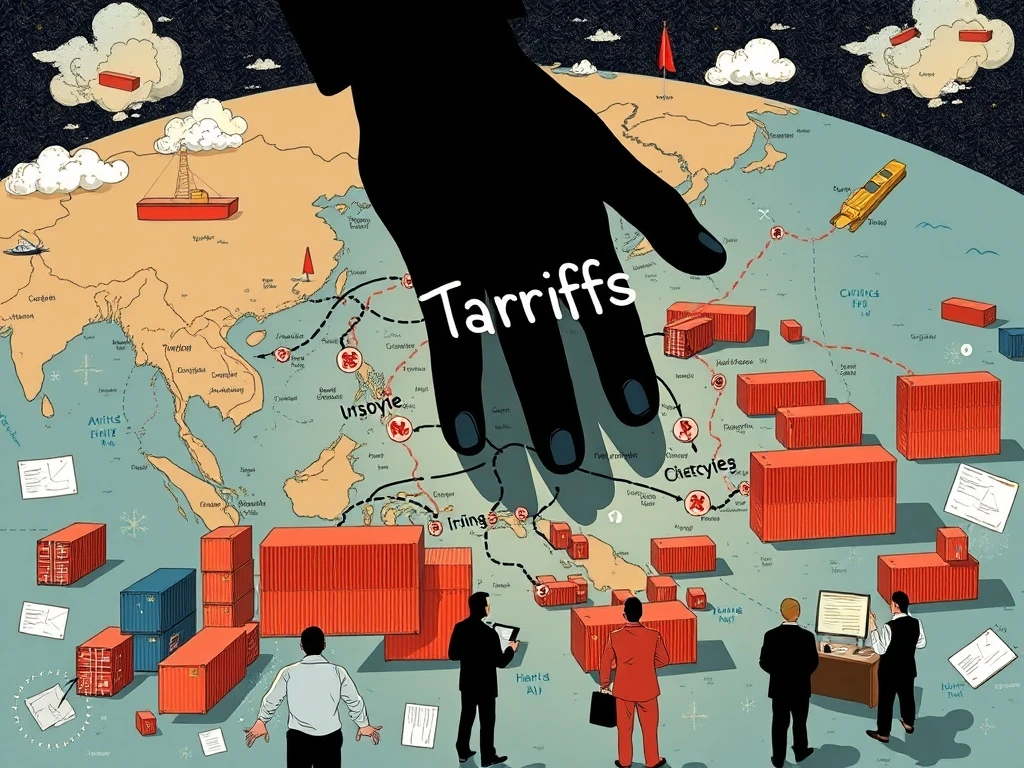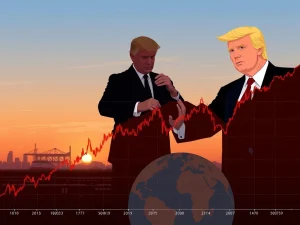Trump Tariffs Unleash Global Chaos: 40% Transshipment Threatens $352B Southeast Asia Exports

In the dynamic world of global finance and digital assets, understanding macroeconomic shifts is paramount. While seemingly distant, major trade policy changes, like the recent Trump tariffs, send ripples across traditional markets that inevitably influence the broader economic sentiment, impacting everything from commodity prices to investor confidence in emerging technologies like cryptocurrency. The current saga unfolding in Southeast Asia, with its multi-billion-dollar export industries facing unprecedented trade uncertainty, serves as a stark reminder of how geopolitical maneuvers can directly affect global supply chains and, by extension, the economic stability that underpins all financial markets.
The Looming Shadow of Trump Tariffs: A New Era of Trade Scrutiny
Donald Trump’s proposed new Asia tariff strategy has plunged exporters across Southeast Asia into a maelstrom of confusion and concern. Nations like Vietnam, Indonesia, and the Philippines, pivotal players in global manufacturing, are grappling with a complex web of ambiguous regulations. At the heart of this storm are two key measures: general tariffs of 20% for Vietnam and 19% for Indonesia and the Philippines on most Southeast Asia exports to the U.S., collectively valued at a staggering $352 billion annually. However, the truly disruptive element is the proposed 40% transshipment tariff.
Trump’s administration claims this higher tariff targets goods routed through third countries specifically to bypass earlier U.S. tariffs on Chinese products. The problem? The lack of precise criteria for defining ‘transshipment’ has left businesses and governments in a perilous limbo. How will the U.S. determine if a product’s value is sufficiently ‘local’ to avoid the penalty? Questions abound:
- Will raw materials sourced from China trigger the 40% tariff?
- Does Chinese labor or capital investment in a Southeast Asian factory qualify as ‘transshipment’?
- What percentage of value-added content is considered acceptable?
This regulatory vacuum forces companies to operate without a clear roadmap, unable to adjust their intricate supply chains or ensure compliance with rules that remain undefined.
Navigating the Quagmire: What Does ‘Chinese-Origin’ Really Mean?
The core of the current trade uncertainty lies in the elusive definition of what constitutes a ‘Chinese-origin’ good when it passes through a third country. For decades, global manufacturing has relied on complex, interconnected supply chains where components and raw materials traverse multiple borders before a final product emerges. The new 40% transshipment tariff threatens to unravel this intricate web without providing clear guidance on how ‘origin’ will be assessed.
Consider the varying approaches:
- Vietnam’s Proactive Stance: Vietnam has attempted to pre-empt U.S. demands by implementing its own rules. These require at least 40% value-added content in final products, compared to imported materials. This means a significant portion of the product’s value must be generated within Vietnam itself, through local labor, processing, or locally sourced components. This proactive measure, while a step towards clarity, still places a considerable burden on manufacturers to prove compliance.
- Indonesia and Thailand’s Dilemma: In contrast, Indonesia and Vietnam have engaged in bilateral negotiations to define ‘rules of origin,’ but concrete thresholds remain elusive. Thailand, which has yet to reach an agreement, faces pressure from U.S. officials to boost local content by a staggering 60-80% to avoid potential penalties. This high threshold is particularly challenging for industries deeply integrated with Chinese supply lines.
U.S. trade officials openly admit they are still finalizing these crucial transshipment tariff rules, with an initial deadline of August 1 for implementation. This delay, far from offering relief, exacerbates the problem, forcing manufacturers to make preemptive, costly, and potentially unnecessary adjustments to their operations.
Southeast Asia Exports Face Unprecedented Supply Chain Disruption
The implications for Southeast Asia exports are profound. The region’s export volume to the U.S. has steadily climbed, from 11% in 2018 to 15% currently, demonstrating its growing importance in global trade. However, the proposed Trump tariffs strategy threatens to curb this growth, potentially reversing years of economic progress and diversification.
The core challenge leading to widespread supply chain disruption is the heavy reliance on Chinese industrial components. Analysts estimate that a significant 60-70% of Southeast Asian exports incorporate Chinese parts. Meeting new benchmarks, such as Vietnam’s 30% cap on Chinese raw materials and 40% value threshold, demands a radical overhaul:
- Supplier Overhaul: Companies must identify and onboard new suppliers outside of China, a process that is time-consuming, expensive, and often involves compromising on cost or quality.
- Labor Model Adjustments: Increased local content may require expanding local labor forces, potentially leading to higher labor costs and training requirements.
- Pricing Strategies: The increased costs associated with supply chain restructuring will inevitably impact product pricing, potentially making Southeast Asian goods less competitive in the U.S. market.
Countries like Vietnam, Malaysia, and Thailand have already introduced stricter customs policies and rules-of-origin requirements in an attempt to align with anticipated U.S. demands. Yet, the effectiveness and enforcement of these new domestic regulations remain uncertain, adding another layer of complexity to an already opaque situation.
The Broader Economic and Geopolitical Fallout of Trade Uncertainty
The current climate of trade uncertainty extends far beyond the immediate economic impact on Southeast Asia exports. It poses significant broader economic risks and carries considerable geopolitical implications. The inconsistent approach by the U.S. administration, characterized by alternating between punitive measures and diplomatic outreach, undermines the long-term planning essential for businesses dependent on stable Asian supply chains.
For smaller economies, the situation is particularly precarious. They risk being trapped between the protectionist policies of the U.S. and their fundamental need to diversify export markets to ensure economic resilience. The European Union, too, faces similar apprehension amid renewed U.S. tariff threats, highlighting a global shift towards a more fragmented and unpredictable trade landscape.
This lack of coherent frameworks has compelled corporations to pivot from strategic long-term planning to reactive, short-term adjustments. Tech firms, for instance, are actively relocating production facilities outside traditional U.S.-China trade zones, a costly and complex endeavor driven by regulatory fear rather than market efficiency. As one analyst succinctly put it, Trump’s erratic policies appear to prioritize short-term political gains over fostering stable, predictable international trade relations. The only constant, it seems, is the pervasive confusion.
Addressing Supply Chain Disruption: What Lies Ahead?
The profound supply chain disruption triggered by the impending transshipment tariff demands immediate attention and clearer policy. Companies are currently in a holding pattern, awaiting concrete rules that will dictate their future operational strategies. Countries are engaged in bilateral negotiations, often in a vacuum of official U.S. guidelines, attempting to preemptively define ‘rules of origin’ and local content thresholds.
The fundamental question of ‘too much China’ remains unanswered, leaving businesses to guess at the acceptable levels of Chinese input. This regulatory environment transforms U.S. trade policy into a dual-purpose tool: an economic lever to influence trade balances and a geopolitical instrument to reshape global alliances and manufacturing hubs. For Asian exporters, this translates into a precarious balancing act, navigating a landscape where the rules of engagement are constantly shifting and often opaque.
In conclusion, the looming 40% transshipment tariff and the broader Trump tariffs strategy have cast a long shadow over the $352 billion Southeast Asia exports to the U.S. The resulting trade uncertainty and the immense potential for supply chain disruption demand urgent clarity from U.S. trade officials. Without defined rules, businesses face an uphill battle, forced to make costly decisions in the dark, impacting not just their bottom lines but the stability of global trade and the broader economic landscape.
Frequently Asked Questions (FAQs)
What is the primary concern for Southeast Asian exporters regarding the new Trump tariffs?
The primary concern is the ambiguity surrounding the 40% transshipment tariff. Exporters are unclear on what constitutes ‘Chinese-origin’ goods and how much local content is required to avoid this punitive tariff, making it difficult to adjust supply chains and comply with future regulations.
Which Southeast Asian countries are most affected by these new trade policies?
Vietnam, Indonesia, and the Philippines are explicitly mentioned as being significantly affected by the general tariffs (20% for Vietnam, 19% for Indonesia and Philippines). Thailand also faces pressure regarding local content requirements to avoid penalties, indicating widespread regional impact.
How are businesses in Southeast Asia attempting to adapt to the trade uncertainty?
Businesses are being forced to preemptively adjust their supply chains, seeking non-Chinese raw material suppliers, and rethinking labor models. Some countries, like Vietnam, have introduced their own rules, such as a 30% cap on Chinese raw materials and a 40% value-added content threshold, pushing firms to overhaul their operations.
What does ‘transshipment’ mean in the context of these tariffs?
In this context, ‘transshipment’ refers to goods routed through third countries (like those in Southeast Asia) to bypass earlier U.S. tariffs primarily imposed on goods directly from China. The 40% transshipment tariff is designed to penalize products that are deemed to have insufficient local value-add and are merely passing through a third country to avoid tariffs.
What are the broader economic and geopolitical implications of these tariffs?
Beyond direct economic impact, the tariffs create significant trade uncertainty, undermining long-term business planning. Geopolitically, smaller economies risk being caught between U.S. protectionism and the need to diversify. The inconsistent U.S. approach fosters global fragmentation, pushing companies to costly production relocations and prioritizing short-term political gains over stable international trade.









